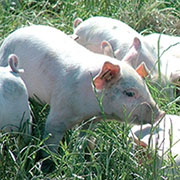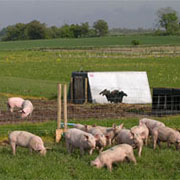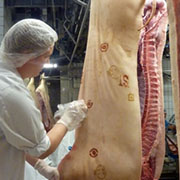SafeOrganic



More about the project
Main results and conclusions
The level of antimicrobial resistance in bacteria from organic vs. conventional pigs has been compared for approximate 25 herds of each production system in DK, FR, IT and SE, by sampling faeces at farm or colon content at slaughterhouse from two pigs per herd.
- An E. coli isolate was obtained from each sample and subjected to analysis of MIC (minimum inhibitory concentration) values for comparison of the resistance towards 10 antibiotics between production systems. Resistance to ampicillin, streptomycin, sulphonamides, tetracycline and trimethoprim was most common – ranging from 14% to 75% of E. coli isolates from conventional pigs and from 1% to 46% of isolates from organic pigs. The resistance towards these five antibiotics varied markedly between the four countries, but the resistance was always significantly lower in organic pigs than in conventional pigs, except for tetracycline in Sweden, where both production systems had a low occurrence.
- However, DNA based real-time PCR quantification of cat, strA, sul2, sul1, tetA and tetB genes encoding resistances to chloramphenicol, streptomycin, sulphonamides and tetracycline, respectively, was unable to show a difference in the occurrence of resistance genes in the microbiota of organic vs. conventional pigs from the same country.
- The quantitative level of antimicrobial resistance carried by the individual animal in faeces /intestinal content and on the carcass was assessed by determining the number of E. coli resistant to tetracycline (TET), out of total E. coli (i.e. proportion of TET E. coli). Tetracycline is one of the most commonly used antimicrobials in swine production. Except from Sweden, TET resistant E. coli was found in close to all pigs of both organic and conventional origin in DK, FR and IT. This was unexpected considering the restrictions on antimicrobial usage in organic pig production. Still, the proportion of E. coli carrying TET resistance in the colon was significant lower in the organic pigs, except in Sweden where both production systems had a low occurrence
- Organic pigs are often slaughtered together with conventional pigs implying a risk of contaminating organic pork with resistant bacteria. Therefore, the bacteria present in pigs’ own intestinal content was compared with those present on their carcass at end of slaughter to elucidate potential cross-contamination. In France and Denmark, the prevalence of TET resistant E. coli was generally lower on the carcasses than in the colon. However, the observed difference in the proportion of TET resistant E. coli in the colon of organic vs. conventional pigs was no longer apparent on carcasses. This may indicate that organic pigs are prone to lose their inherent lower level of resistance during the slaughter process. France is already slaughtering organic pigs before conventional, which points to the importance of hygienic measures in general.
- Different methods were applied in the search for potential markers for (imprudent) antibiotic use in organic animal production. The genetic diversity of bacteria was suggested to be a possible marker as the diversity was hypothesised to be higher in organic pigs due to less selection pressure from antimicrobials. This could however, not be supported as DNA genotyping by PFGE (pulse-field gel electrophoresis) in France revealed a very high genetic diversity of E. coli strains in both production systems and it was not possible to associate specific PFGE profiles to either organic or conventional origin. Also an examination of pigs’ entire intestinal microbiota by pyrosequencing was unable to resolve a difference between organic and conventional pigs. Alternatively, differences in antibiotic resistance profiles were investigated by PCA (Principal Component Analysis) for the potential as marker. PCA of MIC data for E. coli (IT and SE) was shown to be able to point out organic herds with unusual (conventional-like) resistance profiles. The PCA analysis is seen as a promising tool to enable a more targeted control of antimicrobial consumption in organic pig production.
- Sampling at slaughterhouses is easier and more cost-effective than sampling of live animals at each farm, but foreign bacteria ingested from the surrounding environment (truck, lairage) may bias results obtained at slaughter. Therefore, we investigated for an intestinal sampling site where the level of antibiotic resistance can be considered to resemble the herd status. This was done by assessing the time for ingested particles to reach different intestinal sampling points. The particles were found to reach the mid-colon in 2 of 6 pigs within 4 h. However, the proportion of TET resistant E. coli in each pig seemed stable in both caecum and mid-colon independent on sampling time (up to 8 h). This supported that that our sampling procedure at slaughterhouse fitted the purpose of our project.
SafeOrganic
 6 partners, 5 countries
6 partners, 5 countries
Coordinator
PhD, Research Leader Søren Aabo, Technical University of Denmark, National Food Institute, Denmark
Partners
Dr. Antonia Ricci, Istituto Zooprofilattico Sperimentale delle Venezie, Italy
Dr. Martine Denis, French Agency for Food, Environment, and Occupational Health Safety, France
DVM, PhD Björn Bengtsson, National Veterinary Institute, Sweden
Professor Anders Dalsgaard, University of Copenhagen, Denmark
Assoc. Prof. Ivan Rychlik, Veterinary Research Institute, Czech Republic
Project stakeholders
The target groups entail the entire organic pork production chain from farmer to slaughterhouses to retail and finally the consumer. The result will also be relevant for organic control authorities and European Commission decision makers. Additionally, the obtained knowledge will be communicated to the scientific community in general.
